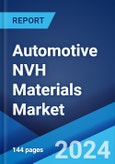Automotive NVH materials, also known as noise, vibration, and harshness materials, are used to reduce unwanted noise, vibrations (oscillations due to automobile mechanics), and harshness (the level of discomfort) in automobiles. NVH materials, including molded rubbers, metal and film laminates, molded foams and engineering resins, are used to control air and structure-borne noises as well as noise generated from the interior components of the vehicles. In recent years, there has been a heightened demand for NVH materials as they absorb noise and prevent it from entering the vehicle, thereby preventing discomfort and improving the ride quality.
Market Trends
Over the past few years, the sales of automobiles in emerging regions like India and China have been rising steadily. The strict government regulations for reducing vehicle noise levels are increasing the demand for NVH materials in these regions. Moreover, several manufacturers are developing lightweight vehicles with enhanced fuel efficiency which helps in improving the noise and vibration quality of the vehicles. They are also focusing on mergers and acquisitions (M&A) to enhance their portfolio for NVH solutions. Some of the other factors that are currently driving the market growth are the influence of NVH and Vehicle Refinement Levels on buying decisions, advanced NVH products with innovative technologies, changing lifestyles and rising incomes in both developed and developing economies.Market Segmentation
This report provides an analysis of the key trends in each sub-segment of the global automotive NVH materials market report, along with forecasts at the global and regional level from 2025-2033. The report has categorized the market based on product, vehicle type and application.Breakup by Product
- Polyurethane
- Mixed Textiles Fibers
- Fiber Glass
- Polyester Fiber
- NBR
- Polypropylene
- PVC
- Textile Materials (Synthetic)
- Textile Materials (Cotton)
Breakup by Vehicle Type
- Passenger Vehicles
- LCV
- HCV
Breakup by Application
- Trunk Module
- Floor Module
- Wheel Arches
- Cockpit Module
- Roof Module
- Engine Casing
- Bonnet Liners
Breakup by Region
- Asia Pacific
- Europe
- North America
- Middle East and Africa
- Latin America
Competitive Landscape
The competitive landscape of the market has also been examined with some of the key players being BASF SE, The DOW Chemical Company, ExxonMobil, 3M Company, Mitsui Chemicals, Inc., Sumitomo Riko Company Limited, Covestro AG, Celanese Corporation, Huntsman Corporation, Lanxess AG and Borgers AG.Key Questions Answered in This Report
1. What is the market size of the automotive NVH materials market?2. What is the growth rate of the automotive NVH materials market?
3. What are the key factors driving the global automotive NVH materials market?
4. What has been the impact of COVID-19 on the global automotive NVH materials market?
5. What is the breakup of the global automotive NVH materials market based on the product?
6. What is the breakup of the global automotive NVH materials market based on the vehicle type?
7. What is the breakup of the global automotive NVH materials market based on the application?
8. What are the key regions in the global automotive NVH materials market?
9. Who are the key players?
10. What is the largest segment of the automotive NVH materials market?
Table of Contents
Companies Mentioned
- BASF SE
- The DOW Chemical Company
- ExxonMobil
- 3M Company
- Mitsui Chemicals Inc.
- Sumitomo Riko Company Limited
- Covestro AG
- Celanese Corporation
- Huntsman Corporation
- Lanxess AG
- Borgers AG
Methodology

LOADING...
Table Information
| Report Attribute | Details |
|---|---|
| No. of Pages | 141 |
| Published | February 2025 |
| Forecast Period | 2024 - 2033 |
| Estimated Market Value ( USD | $ 13.6 Billion |
| Forecasted Market Value ( USD | $ 19.9 Billion |
| Compound Annual Growth Rate | 4.3% |
| Regions Covered | Global |
| No. of Companies Mentioned | 11 |









